HDMI 2.1 is the latest upgrade to the HDMI Specification. This roundup reviews the new features of HDMI 2.1 and the available options if you want to upgrade to a new HDMI 2.1 monitor.
Introduced in 2017, HDMI 2.1 has finally found its way to the market, with a few products already available for consumers to buy. LG and Samsung are the early adopters of HDMI 2.1, while the next-gen consoles Xbox Series X and PlayStation 5 both feature the latest HDMI specification.
Here are the best HDMI 2.1 monitors you can buy right now and what to know when looking to buy a new HDMI 2.1 monitor.
Table of Contents
More Bandwidth, Higher Resolution
HDMI 2.1 adds more bandwidth to the current 2.0 specification. HDMI will now support 48Gbps, which is higher than DisplayPort 1.4 and Thunderbolt 3.
HDMI 2.1 increases the bandwidth to 48Gbps, capable of handling 4K at 120Hz (4K60 4:4:4 HDR), 8K60 with 4:4:4, and resolutions up to 10K120Hz.
Due to the limitations of HDMI 2.0 bandwidth, you could only get 4K at 60Hz. HDMI 2.1 increases the refresh rate to 120Hz at 4K and up 8K60Hz resolution with no compression. HDMI 2.1 monitors will now support native 4K120Hz resolution with 10-bit color depth at 4:4:4 with VRR and HDR over HDMI, improving visual fidelity significantly.
A higher refresh rate means smooth and fluid gameplay. Besides, only monitors with HDMI 2.1 can get the best of the next-gen gaming consoles. The new HDMI specification is a winning choice for both gamers and professionals looking for the best performance possible.
Here is a detailed comparison of the latest HDMI 2.1 specification and other video connectivity protocols, including DisplayPort and Thunderbolt 3.
HDMI 2.1 and Gaming
Besides the higher refresh rates, another exciting feature for gamers is the support for Variable Refresh Rate (HDMI Forum VRR). Like FreeSync and G-Sync, the HDMI group comes with its own VESA Adaptive-Sync protocol to eliminate tearing and stuttering.
The best part is that you don’t need a monitor that supports FreeSync or G-Sync to enable HDMI Forum VRR. Having an HDMI 2.1 GPU and HDMI 2.1 monitor will allow you to enjoy VRR for smooth gameplay without visual artifacts such as screen tearing.
We don’t know much about how manufacturers are going to implement HDMI Forum VRR, but the prospect seems promising. HDMI 2.1 monitors can still support G-Sync or FreeSync, depending on the manufacturer.
Best HDMI 2.1 Monitors Compared
The Best HDMI 2.1 Monitors – Our Picks
| Image | Product | Details | Check Price |
|---|---|---|---|
 | ASUS ROG Swift PG32UQ | Screen Size: 32 inches Resolution: 4K (3840x2160) Refresh Rate: 144Hz Panel Type: IPS HDR: VESA DisplayHDR 600 Ports: 2x HDMI 2.1, 1x DisplayPort, 2x USB 3.0 | Check on Amazon |
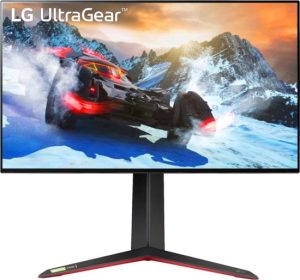 | LG UltraGear 27GP950 | Screen Size: 27 inches Resolution: 4K (3840x2160) Refresh Rate: 144Hz (160Hz OC) Panel Type: IPS HDR: VESA DisplayHDR 600 Ports: 2x HDMI 2.1, 1x DisplayPort, 3x USB 3.0, Headphone jack | Check on Amazon |
 | Acer Nitro XV282K KVbmiipruzx | Screen Size: 28 inches Resolution: 4K (3840x2160) Refresh Rate: 144Hz Panel Type: IPS HDR: VESA DisplayHDR 400 Ports: 2x HDMI 2.1, 1x DisplayPort, 1x USB-C (65W, DP Alt. Mode) 3x USB 3.1, Headphone | Check on Amazon |
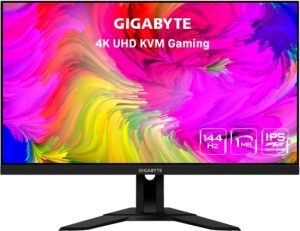 | GIGABYTE M28U Gaming Monitor | Screen Size: 28 inches Resolution: 4K (3840x2160) Refresh Rate: 144Hz Panel Type: IPS HDR: VESA DisplayHDR 400 Ports: 2x HDMI 2.1, 1x DisplayPort 1.4, 1x USB-C, 3x USB 3.0 | Check on BestBuy |
 | ASUS ROG STRIX XG43UQ | Screen Size: 43 inches Resolution: 4K (3840x2160) Refresh Rate: 144Hz Panel Type: IPS HDR: VESA DisplayHDR 1000 Ports: 2x HDMI 2.1, 1x DisplayPort, 2x USB 3.0, Headphone jack | Check on Amazon |
 | Samsung Odyssey Neo G9 | Screen Size: 49 inches Resolution: DQHD (5120x1440) Refresh Rate: 240Hz Panel Type: VA, Mini LED HDR: VESA DisplayHDR 2000 Ports: 2x HDMI 2.1, 1x DisplayPort 1.4, 2x USB 3.0 | Check on Amazon |
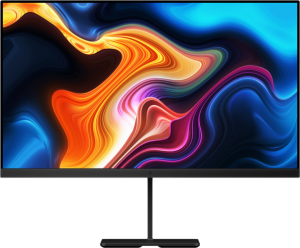 | Eve Spectrum 4K 144Hz | Screen Size: 27 inches Resolution: 4K (3840x2160) Refresh Rate: 144Hz Panel Type: IPS HDR: VESA DisplayHDR 600 Ports: 2x HDMI 2.1, 1x DisplayPort 1.4, 2x USB-C, 2x USB-A 3.1 Gen 2, Headphone | Check on EveDevices |
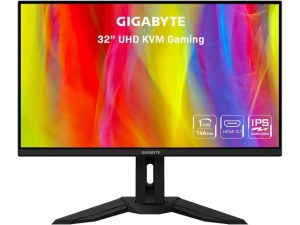 | GIGABYTE M32U Gaming Monitor | Screen Size: 32 inches Resolution: 4K (3840x2160) Refresh Rate: 144Hz Panel Type: IPS HDR: VESA DisplayHDR 400 Ports: 2x HDMI 2.1, 1x DisplayPort 1.4, 1x USB-C, 2x USB 3.0 | Check on Newegg |
 | ASUS ProArt Display PA32UCG-K | Screen Size: 32 inches Resolution: 4K (3840x2160) Refresh Rate: 120Hz Panel Type: IPS, Mini LED HDR: VESA DisplayHDR 1600 Ports: 2x Thunderbolt 3, 1x HDMI 2.1, 1x HDMI 2.0, 1x DisplayPort 1.4, 3x USB 3.1, Headphone | Check on Amazon |
1. ASUS ROG Swift PG32UQ – 32-Inch 4K 144Hz HDMI 2.1 Monitor
ASUS is one of the best brands in the market for premium gaming monitors and peripherals. Its ROG Swift PG32UQ is, in many ways, the best HDMI 2.1 monitor you can buy today, offering everything you would want in a premium gaming monitor. The 32-inch panel is the perfect size for 4K gaming; it is large for an immersive gaming experience but not too large to have a dampening effect on the picture quality.
Obviously, the standing out feature for this monitor is the support for HDMI 2.1. The PG32UQ has two HDMI 2.1 ports with full 48Gbps bandwidth, enabling 4K gaming at a 120Hz refresh rate on the PS5, Xbox Series X, and the latest gaming PCs. This monitor can also support up to 144Hz at 4K on next-gen gaming PCs with DisplayPort 1.4.
The ROG Swift PG32UQ is among the few gaming monitors that support the full 48Gbps bandwidth of HDMI 2.1 and its features, including 4K120, Auto Low Latency Mode to enable Game Mode in monitors automatically, and HDMI 2.1 VRR.
However, HDMI 2.1 support isn’t the only star of the show here. The PG32UQ has deep and vibrant colors, and VESA DisplayHDR 600 makes everything pop when gaming or watching content. Motion handling is outstanding, thanks to its fast 1ms response times, powerful overdrive settings, and FreeSync Premium Pro and G-Sync support. It’s an excellent monitor for competitive gaming, and it should please most FPS and eSports players.
The cybernetic-inspired design and RGB lighting at the back fit perfectly in the gamer ecosystem. The included stand has decent ergonomics, with height, tilt, and swivel adjustments. You get two HDMI 2.1 ports, one DisplayPort 1.4, two USB 3.0 ports, and a headphone jack onboard.
The max power output for the USB-C port is 65 Watts, easily charging most notebooks and ultrabooks, and it is one of the highest outputs out there. Remember to check again if you plan on buying a bigger size model, as it will need more juice for itself, limiting the output it can deliver via the USB-C port.
📍 Looking for alternatives with higher resolution or wider screens? Check out this 34″ LG WQHD ultrawide monitor available in Romania — a great productivity option with solid specs and local pricing.
Our TakeThe ASUS ROG Swift PG32UQ is the benchmark for HDMI 2.1 monitors, excelling in gaming performance, image quality, and build quality. It comes with two HDMI 2.1 ports and has one of the best displays we’ve seen in a long time.
- Higher refresh rate gaming, up to 144Hz
- Wide color gamut
- DisplayHDR 600
- Great motion handling
- Plenty of gaming features
- Ergonomic stand
- No pivot adjustment
2. LG UltraGear 27GP950 – 27-inch 4K 144Hz Gaming Monitor with HDMI 2.1
The LG UltraGear 27GP950 gaming monitor is built to get the best out of next-generation gaming PCs. It has a 4K display that runs at a 120Hz refresh rate on the latest gaming consoles and up to 160Hz on PCs for buttery-smooth gameplay. It’s the fastest HDMI 2.1 monitor you can buy today.
The 27GP950 comes with the trademark UltraGear look with the LG Sphere lighting ring (RGB) at the back and red accents. The monitor itself is black with a 4-side virtually borderless display and matte finish to reduce reflection. Like the 27GN950, it offers tilt, pivot, and height adjustments.
The display is 27-inch with a native 4K (3840X2160) resolution and IPS panel. It has outstanding color reproduction and clarity with up to 98% coverage of the DCI-P3 color gamut. The monitor is VESA DisplayHDR 600 certified for improved dynamic range and lifelike visuals. The 27GP950 isn’t just for gaming, though. With high color accuracy and HDR support, this monitor makes a good option for content consumption and creative work.
The UltraGear 27GP950 has a bunch of impressive gaming features up its sleeves. First, it has a native 144Hz refresh rate, which is overclockable to 160Hz on PCs. It supports 1ms Gray-to-Gray response time for improved clarity on fast-paced scenes and FreeSync Premium Pro, which includes LFC and FreeSync HDR. Then HDMI 2.1 adds support for 4K gaming at 120Hz on the latest consoles. Overall, the 27GP950 can handle just about anything gamers throw at it.
For connectivity, the UltraGear 27GP950 comes with one DisplayPort 1.4 input, two HDMI 2.1 (the main upgrade over the 27GN950), two USB ports, and a headphone jack. To achieve 4K at 144Hz, you’ll need to use the DisplayPort with DSC (Display Stream Compression), which means the 160Hz refresh rate will only be available for PCs.
Our TakeIf you’re a PC gamer, the LG UltraGear 27GP950 is the best HDMI 2.1 monitor to get. It supports high framerate gaming of up to 160Hz at 4K with all the usual VRR bells and whistles and in-game enhancements. Of course, you can still get 4K120 gameplay on the new consoles with HDMI 2.1.
- Overclockable refresh rate up to 160Hz
- Faster response time
- Brilliant colors
- DisplayHDR 600
- Plenty of gaming features
- Lacks swivel adjustment
3. Acer Nitro XV282K KVbmiipruzx – 28 Inch 4K 144Hz Monitor with HDMI 2.1
The Acer Nitro XV282K KVbmiipruzx is an excellent alternative to the LG UltraGear 27GP950. It has much better ergonomics, better reflection handling in bright rooms, and a good range of ports, including a USB-C port for Mac users. This is Acer’s first HDMI 2.1 monitor, and it has a lot in stock for both console and PC gamers.
The Nitro XV282K comes with a clean design featuring thin bezels and a fully ergonomic stand. You can tilt, swivel, pivot, or height-adjust the monitor to find the sweet spot for gaming. While it is marketed as a gaming monitor, there are no RGB lighting or weird patterns, so you can easily use it in an office. Besides, the monitor features a USB-C port with 65W Power Delivery, making it easy to connect your work computer. The monitor supports 100×100 mm VESA mounts for even better office ergonomics.
The display is a 28-inch screen with 4K (3840×2160) resolution running on an IPS panel. It’s very crisp and sharp at 28 inches and has excellent viewing angles. Color reproduction is equally impressive. This monitor covers 90% DCI-P3, producing over a billion colors perfect for photographers and creative pros. Unfortunately, while the colors are great, the HDR picture quality is worse. The monitor’s low contrast ratio and low peak brightness cannot produce a true HDR experience. The LG UltraGear 27GP950 is a much better option for HDR gaming.
In addition to 4k120 on the latest gaming consoles, the monitor supports 144Hz at 4k with Display Stream Compression (DSC). It also features FreeSync Premium (which includes LFC) with a 48-144Hz range for smooth and tear-free gaming. LFC kicks in when the frame rates drop below 48fps to prevent screen stuttering. eSports and competitive gamers will appreciate the 1ms response time (GtG).
DSC allows for 4K passthrough at 144Hz refresh rate with HDR, but it requires at least an RTX 20 series or RX 5700 series GPU.
The ports included in this monitor include two HDMI 2.1 inputs, a single DisplayPort 1.4 with DSC, a USB-C port with 65W PD charging, four USB Type-A 3.0 ports, and USB Type-B upstream, and a headphone output. The USB-C port is excellent for users looking to add a new monitor to their home office that’s great for both gaming and work.
Our TakeThe Acer Nitro XV282K KVbmiipruzx is an outstanding monitor for gaming. While it doesn’t have an overclockable refresh rate like the LG, the 144Hz refresh rate on PC and 120Hz on consoles is fast enough for smooth and responsive gaming. This monitor also includes a USB-C port, which caters to the Mac and gamer user base.
- High refresh rate and fast response time
- FreeSync VRR
- Option backlit strobing feature
- Vibrant colors and wide viewing angles
- Clean design
- Fully adjustable stand
- Poor HDR picture quality
4. GIGABYTE M28U Gaming Monitor – Budget 4K 144Hz HDMI 2.1 Gaming Monitor
The GIGABYTE M28U Gaming Monitor is a budget 4K 144Hz monitor with HDMI 2.1 ports. It’s a perfect choice if you don’t want to spend a lot of money on a gaming monitor. The good thing is that you don’t miss out on anything crucial; this is a capable and feature-rich monitor that can bring out the best in the latest consoles and gaming PCs.
The M28U supports 4K gaming at 120FPS on the PS5 and Xbox Series X and up to 144FPS on gaming PCs. Motion handling is outstanding. The 1ms response time makes objects in motion appear clearer with no noticeable blur, making this monitor a good choice for fast-paced and competitive gaming. It’s also FreeSync Premium Pro certified for a tear-free and stutter-free gaming experience.
The M28U is based on an IPS panel and covers 94% of the DCI-P3 color gamut for vibrant colors. The 4K resolution is sharp at 28 inches, allowing you to see every detail when gaming, watching or creating content. There is VESA DisplayHDR 400 support, although you won’t get a true HDR experience 1000:1 contrast ratio and 300nits.
Like most monitors in this list, the M28U has two HDMI 2.1 inputs and one DisplayPort 1.4. There is also a USB-C port with DisplayPort 1.4 Alt Mode and a USB hub. The M28U has an integrated KVM switch, which you can use to control two PCs connected to the monitor using one set of keyboard and mouse.
Our TakeThe GIGABYTE M28U Gaming Monitor offers everything you need for next-gen gaming in an affordable package. It supports a high refresh rate of up to 144Hz at 4K and offers additional features such as an integrated KVM switch, USB-C port with display support, and USB hub.
- Incredible value
- FreeSync VRR up to 144Hz
- Gaming-focused features
- Wide color gamut
- USB-C port, USB hub, and KVM switch
- Lacks swivel and pivot adjustments
5. ASUS ROG STRIX XG43UQ – 43-Inch 4K 144Hz HDMI 2.1 Gaming Monitor
When it comes to console gaming, TVs have been the preferred option because of their large size, rich color reproduction, and excellent HDR picture quality. However, thanks to developments in panel technology in recent years, monitors are slowly becoming the best displays for console gaming.
The ASUS ROG STRIX XG43UQ has everything you would want in a console gaming display; it has a large 43-inch panel and true-to-life colors with 90% DCI-P3 color gamut and DisplayHDR 1000. It supports smooth 4K 120Hz gaming on the PS5 and Xbox Series X along with the new HDMI 2.1 features: HDMI VRR and ALLM.
The ROG STRIX XG43UQ is also excellent for PC gamers who want to play games on a big screen. It supports up to 144Hz on PC with a 1ms response time for smooth and crystal-clear gameplay. It’s FreeSync Premium Pro certified and has plenty of in-game enhancements such as shadow boost for improved visibility on dark areas, ELMB technology for reduced ghosting, crosshair overlays, and more.
The ROG STRIX XG43UQ comes with two HDMI 2. ports and a DisplayPort 1.4 for video input. It has powerful 10W built-in speakers, a tiltable stand, and a remote control to easily control the monitor from your couch or bed.
Our TakeThe ASUS ROG STRIX XG43UQ is a large 43-inch 4K 144Hz monitor with rich colors, a true HDR experience, and premium gaming features. It’s excellent for console gamers and PC gamers who want to experience modern HDR games in all their glory.
- Large, immersive display
- Deep, rich colors and HDR
- Faster response times and low input lag
- Tactical gaming features
- FreeSync Premium Pro and HDMI 2.1 VRR support
- Poor ergonomics
6. Samsung Odyssey Neo G9 – Ultrawide Monitor with HDMI 2.1 Ports
The Samsung Odyssey Neo G9 is the epitome of image quality and gaming performance in an ultrawide monitor. It’s a 49-inch super ultrawide monitor with two HDMI 2.1 ports and a brand-new Mini LED panel.
The Mini LED panel combined with 2,048 local dimming zones and Quantum HDR2000 (2000 nits peak brightness) deliver the best possible HDR experience you can get on an LED-backlit monitor today. It produces excellent picture quality in SDR and HDR, only bested by OLED displays. Since it can reach higher brightness up to 2,000 nits and has high native contrast, the Odyssey Neo G9 is perfect for both bright and dark rooms.
The Odyssey Neo G9 is designed primarily for gaming with a fast 240Hz refresh rate and a quick 1ms response time, allowing gamers to quickly see and react to in-game actions. It also has a native FreeSync and G-SYNC compatibility to clear choppy frames and tearing for fluid gameplay. The HDMI 2.1 inputs enable high framerate gaming both on PC and consoles, although you’ll get the most out of the Odyssey Neo G9 with a PC.
The design remains unchanged from the last Odyssey G9 model. It has a super-aggressive 1000R curve and glossy white panel. The RGB lighting at the back can now sync to what is displayed on the screen for more immersion. Like most ultrawide monitors, you can’t use the Odyssey Neo G9 in portrait mode; however, you can tilt, swivel, and height-adjust the monitor to find the sweet spot for gaming.
Our TakeThe Samsung Odyssey Neo G9 is a high-end ultrawide monitor with HDMI 2.1 ports. It has a rich and vibrant display, the best local dimming on a monitor yet, and some of the best gaming experiences you can find on any monitor today. However, you must have a heavy wallet and powerful hardware to drive those pixels at 240Hz.
- Large and gorgeous panel
- Brilliant SDR and HDR picture quality
- Excellent peak brightness
- Brilliant contrast and deep blacks
- Quick response time and low input lag
- Super-fast 240Hz refresh rate with VRR
- Heavy
- Expensive
7. Eve Spectrum 4K 144Hz – Community-Driven HDMI 2.1 monitor
Eve Spectrum is a crowd-developed monitor and the first to feature HDMI 2.1 connectivity. Designed by multiple gamers, coders, and designers, this monitor is one solution for gaming and productivity.
Eve Spectrum features an LG 27-inch IPS panel, HDR with up to 750-nits brightness, and a wide P3 color gamut. Impressive specs for designers and developers. The monitor will be available in two resolutions; QHD 1440p and 4K.
The monitor has a 240Hz refresh rate on the QHD panel and up to 144Hz with 4K resolution. And with a 1ms response time, the Eve Spectrum monitor turns out to be an impressive gaming monitor.
The QHD Spectrum also known as Model 2, is the only HDMI 2.1, 1440p, FreeSync monitor announced at this moment.
After using it as a daily driver for more than a week, we wrote a dedicated review for the 4K Eve Spectrum.
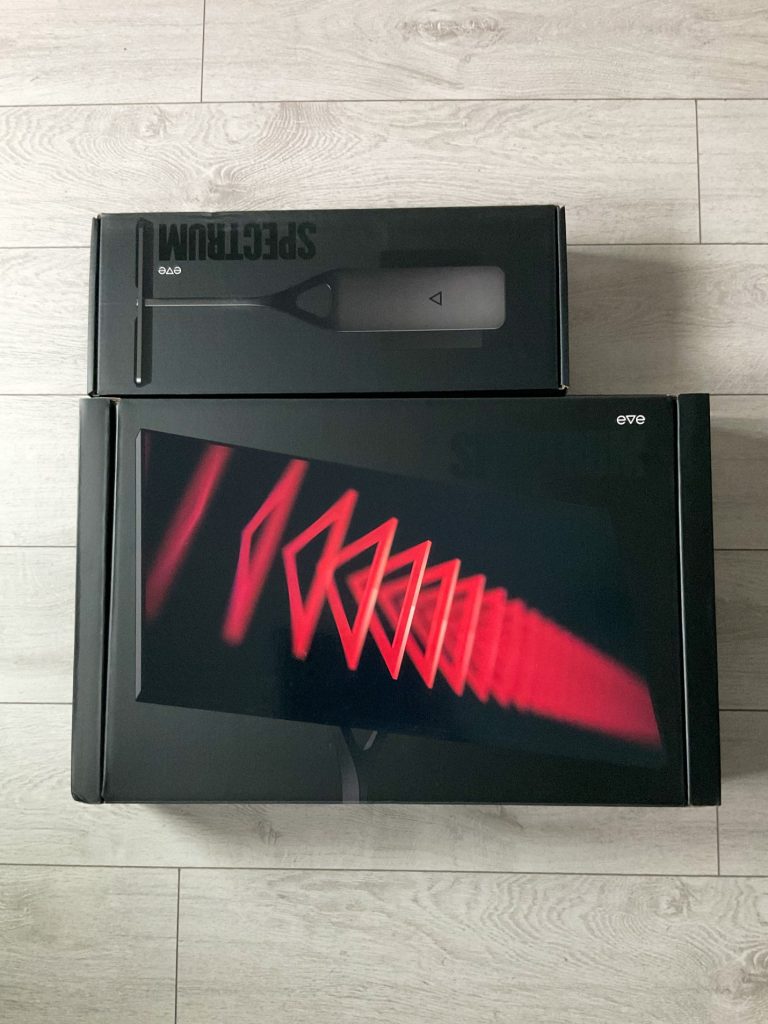
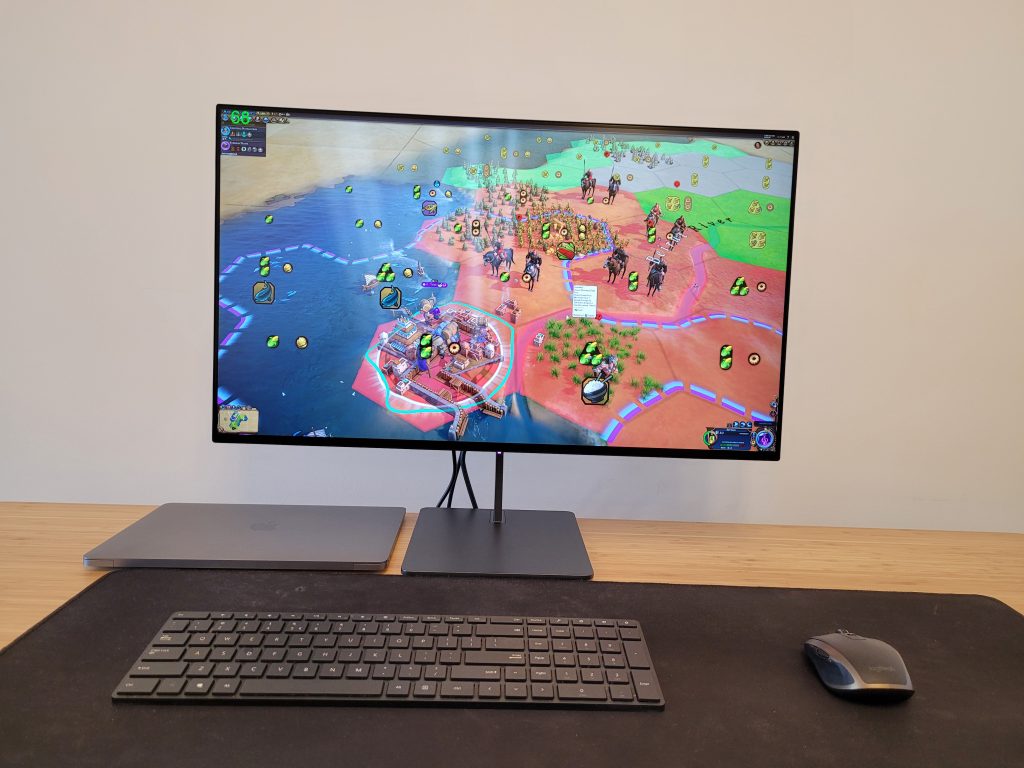
From the outside, the Eve Spectrum 4K 144Hz looks like a monitor that belongs to the office, but make no mistake; this is a capable gaming monitor that will change how you look at gaming monitors forever. Unlike most gaming monitors, the Spectrum comes with a minimal and super-clean design without the usual gamery features and aggressive branding. It also has a fully functional USB-C port that supports power delivery, display, and USB hub.
- Clean, minimal design
- Gorgeous colors
- Fully-featured USB-C port
- Crisp 4K image
- Optional, fully-adjustable stand
- Poor HDR and local dimming
8. GIGABYTE M32U Gaming Monitor – Budget 32-Inch 4K 144Hz Monitor with HDMI 2.1
If you want a 32-inch HDMI 2.1 monitor but don’t want to spring for our top pick, the GIGABYTE M32U is a perfect option for you. It is a budget 32-inch 4K 144Hz gaming monitor with two HDMI 2.1 ports, a USB-C port, and a built-in KVM switch. The M32U supports a powerful 4K 120 on the PS5 and Xbox Series X and up to 4K 144Hz on PCs.
For the money, you’re getting a reasonably bright and colorful IPS panel with wide viewing angles, typical of IPS monitors. Colors are vibrant, with 90% coverage of the DCI-P3 color space. The 4K resolution is sharp and crisp at 32 inches, and you get more screen space than 27-inch monitors.
However, while this monitor is VESA DisplayHDR 400 certified, the 400-nit brightness and 1,000:1 contrast ratio aren’t enough for a true HDR experience.
The M32U is a gaming monitor and comes with it some excellent tactical gaming features and in-game enhancements. It has Aim Stabilizer Sync and crosshair overlays for improved accuracy and clarity and Black Equalizer for enhanced vision in dark areas to spot hiding enemies easily. However, this monitor does not have native support for FreeSync or G-Sync, but it supports Adaptive-Sync, and its 1ms panel performs excellent at reducing motion blur.
Our TakeThe GIGABYTE M32U Gaming Monitor is decent for high framerate gaming on a budget. Compared to other 32-inch 4K high refresh rate gaming displays, the M32U is cheaper and has additional features like a KVM switch and a USB-C port with display support.
- Incredible value
- Large display with sharp images and crisp text
- Quick response time speed
- Gaming-focused features
- Built-in KVM switch
- Great ergonomics and a good range of ports
- Bland design
- Poor HDR performance
9. ASUS ProArt Display PA32UCG-K – Premium HDMI 2.1 Monitor with Thunderbolt 3
The ASUS ProArt Display PA32UCG-K is a professional 32-inch 4K 120Hz monitor with HDMI 2.1 input, dual Thunderbolt 3 ports, a Calman Ready Mini LED display, and HDR 1600. It’s aimed at professionals content creators such as game developers, cinematographers, and more.
The ProArt Display PA32UCG-K has a true 10-bit panel (miles better than 8-bit FRC panels) with 98% DCI-P3, 99.5% Adobe RGB, and 100% Rec. 709 color spaces for exceptional color fidelity. It is factory-calibrated at Delta E of less than 1, so it’s ready to go out of the box. The Mini LED display with 1,152 local dimming zones and HDR 1600 produces outstanding SDR and HDR picture quality for creating and watching content.
The monitor also packs some useful features for the modern home office. Dual Thunderbolt 3 ports allow you to connect your Mac or PC and deliver power for charging at the same time. You can use the second Thunderbolt 3 port to daisy chain other Thunderbolt 3 peripherals to connect even more peripherals to your computer.
There is an HDMI 2.1 port that supports higher refresh rates up to 120Hz, perfect for gamers and game developers, and a USB hub. The monitor supports FreeSync Premium Pro for smooth and fluid gaming. ASUS bundles the monitor with an X-rite i1 Display Pro for hardware calibration.
Our TakeThe ASUS ProArt Display PA32UCG-K is a top-end monitor for professional content creators and developers. It has incredible color accuracy, crisp 4K image, class-leading HDR experience, and smooth 4K 120Hz gaming performance. However, it’s a very expensive monitor, even for professionals.
- Extremely high color accuracy
- Gorgeous Mini LED display
- Dual Thunderbolt 3 ports
- Exceptional local dimming
- Supports Dolby Vision
- Expensive
Choosing the Best HDMI 2.1 Monitor – Our Buying Guide
New HDMI Cables
If you want to enjoy 4k at 120 or 8K, you need to upgrade your cables, specifically to the Ultra-High-Speed HDMI cables. These cables support the HDMI 2.1 specification with a bandwidth of 48Gbps. You can push higher resolution up to 10K and leverage all the features of the latest specification.
HDMI 2.1 Specification Explained
HDMI 2.1 is the latest HDMI specification update to the current 2.0 and supports uncompressed 8K at 60Hz, and resolutions up to 10K. HDMI 2.1 supports other features, including Dynamic HDR, increased 48Gbps bandwidth, eARC, and enhanced gaming and media experience.
So, how does HDMI 2.1 affect you as an average user?
We’ve already seen several consumer devices hitting the market in early 2020, and many being announced. The main question is whether to upgrade to the new HDMI 2.1 or wait for it to become mainstream.
Here is everything you need to know about HDMI 2.1 and all the answers you need to make an informed decision.
What Will HDMI 2.1 Change
The major hype of HDMI 2.1 is the uncompressed 8K60 and 4K120, but there are many more features that this new specification brings to the table. Most of these features are optional, so it’s entirely on the manufacturers to choose which features to implement.
These are the features you get when you buy an HDMI 2.1 monitor:
Increased Bandwidth
HDMI 2.1 increases the bandwidth capacity to 48Gbps. That’s more than double the current HDMI 2.0 bandwidth. With 48Gbps, HDMI 2.1 can carry uncompressed 4K resolution at 120Hz, 8K60, and up to 10K resolution.
We’re looking at refresh rates up to 120Hz of uncompressed 4K, and resolutions up to 10K for immersive viewing and smooth transitions.
With the current HDMI cables supporting up to 18Gbps bandwidth, you’ll need to buy new HDMI 2.1-compliant cables.
When purchasing new HDMI cables, you need to be careful about the marketing gimmicks and terms used by different brands. There is no 2.0 or HDMI 2.1 cable.
There are only three types of HDMI cables. The current ones are High Speed that supports up to 10Gbps, Premium High Speed, supporting 18Gbps, and the new cables from the HDMI 2.1 standard: Ultra High Speed HDMI Cables capable of 48Gbps bandwidth.
Enhanced Audio Return Channel (eARC)
You’ve probably already heard of HDMI ARC in most of the latest TVs and soundbars. Audio Return Channel (ARC) allows you to get audio from a TV to a soundbar or AV receiver through a single HDMI cable.
However, ARC has some limitations. For instance, it does not support advanced file formats like DTS:X, Dolby TrueHD, etc. Due to the limited bandwidth, ARC strips the core 5.1 data stream and reduces it to stereo. In simple terms, you can’t get the best sound quality or multi-directional surround like you would in a movie theater.
On the other hand, eARC supports high-bitrate audio, uncompressed 5.1 and 7.1, 32-channel uncompressed audio, and advanced audio formats such as Dolby Atmos, DTS:X, Dolby TrueHD, and DTS-HD Master Audio. It’s an advancement over ARC that lets you experience movie theater-quality sound at your home’s comfort.
Dynamic HDR
HDMI 2.1 will support Dynamic HDR. Dynamic HDR allows the content source to adjust the HDR data of each scene or frame, providing a more immersive and realistic experience.
We’ve already seen this with Dolby Vision, but the problem is that it is a proprietary technology. Companies need to pay license fees, and also everything from content, source, and TV need to support Dolby Vision.
HDMI 2.1 supporting dynamic HDR allows for interoperability and compatibility with different HDR versions such as HDR10, which requires no license fees.
Variable Refresh Rate (VRR)
VRR syncs the frame rate of the source device, like gaming console, to the display’s refresh rate to eliminates lag, stutter, and frame tearing for a smooth and fluid gaming experience.
With VRR, the source device pushes frames at the fastest speed possible, and thanks to Quick Frame Transport (QFT), the display renders the frames in no time. In case of low frame rates per second, the screen can adjust its refresh rate accordingly to prevent displaying the same frame more than once.
But wait, we’ve heard this before.
It’s Nvidia’s G-Sync and AMD’s FreeSync. But now you don’t need a monitor or TV that supports either technology. If you have an HDMI 2.1 graphics card and display, you can enjoy VRR for smooth gameplay, just like with G-Sync and FreeSync.
Auto Low Latency Mode (ALLM)
ALLM automatically selects the ideal latency settings for uninterrupted viewing. Your TV will automatically switch to Game Mode when you start playing games.
Quick Media Switching (QMS)
QMS Eliminates the delay that causes your screen to blackout when switching between video modes or sources. Do you notice the blank, black screen when you switch from console to Netflix? Well, it’s now gone forever.
Best HDMI 2.1 Monitors Frequently Asked Questions (FAQ)
What monitors have HDMI 2.1?
There are plenty of HDMI 2.1 monitors available from the likes of ASUS, LG, Acer, and Samsung.
Are there HDMI 2.1 content sources in the market?
The newly released PS5 and Xbox Series X supports HDMI 2.1 bandwidth and features. For PC gamers, you’ll need a graphics card from the Nvidia 30 Series or AMD Radeon 6000 series.
To take advantage of these new consoles and next-generation gaming PCs, ensure to prepare yourself with an HDMI 2.1 monitor or TV.
Is HDMI 2.1 backward compatible?
Yes. HDMI 2.1 is backward compatible with the last-gen specifications. You will be able to connect last-gen gaming consoles to a new HDMI 2.1 monitor, and it will work just fine. On the other hand, older HDMI monitors will still wok with the latest gaming consoles with HDMI 2.1.
What will VRR over HDMI 2.1 mean for G-Sync and FreeSync?
In addition to HDMI VRR, HDMI 2.1 displays will still support G-Sync and FreeSync, but it’s up to the manufacturer to decide which VESA Adaptive-Sync technology to include. Therefore, expect to see HDMI 2.1 monitors that support G-Sync, FreeSync, or even both.
How to tell if a monitor supports HDMI 2.1
The best way is to tell if a monitor supports HDMI 2.1 is to check the manufacturer’s product page. There is no way to identify the HDMI version just by looking at its port; all HDMI ports have the same physical connector.
What is the difference between HDMI 2.0 and 2.1?
HDMI 2.0 has a bandwidth of 18Gbps, while the new specification increases the bandwidth to 48Gbps. HDMI 2.1 can support 8K 60K and up to 10K, which guarantees beautiful and crystal-clear images.
What video resolution does HDMI 2.1 support?
HDMI 2.1 supports 4K120Hz, 8K60Hz, and up to 10K120Hz with Display Stream Compression.


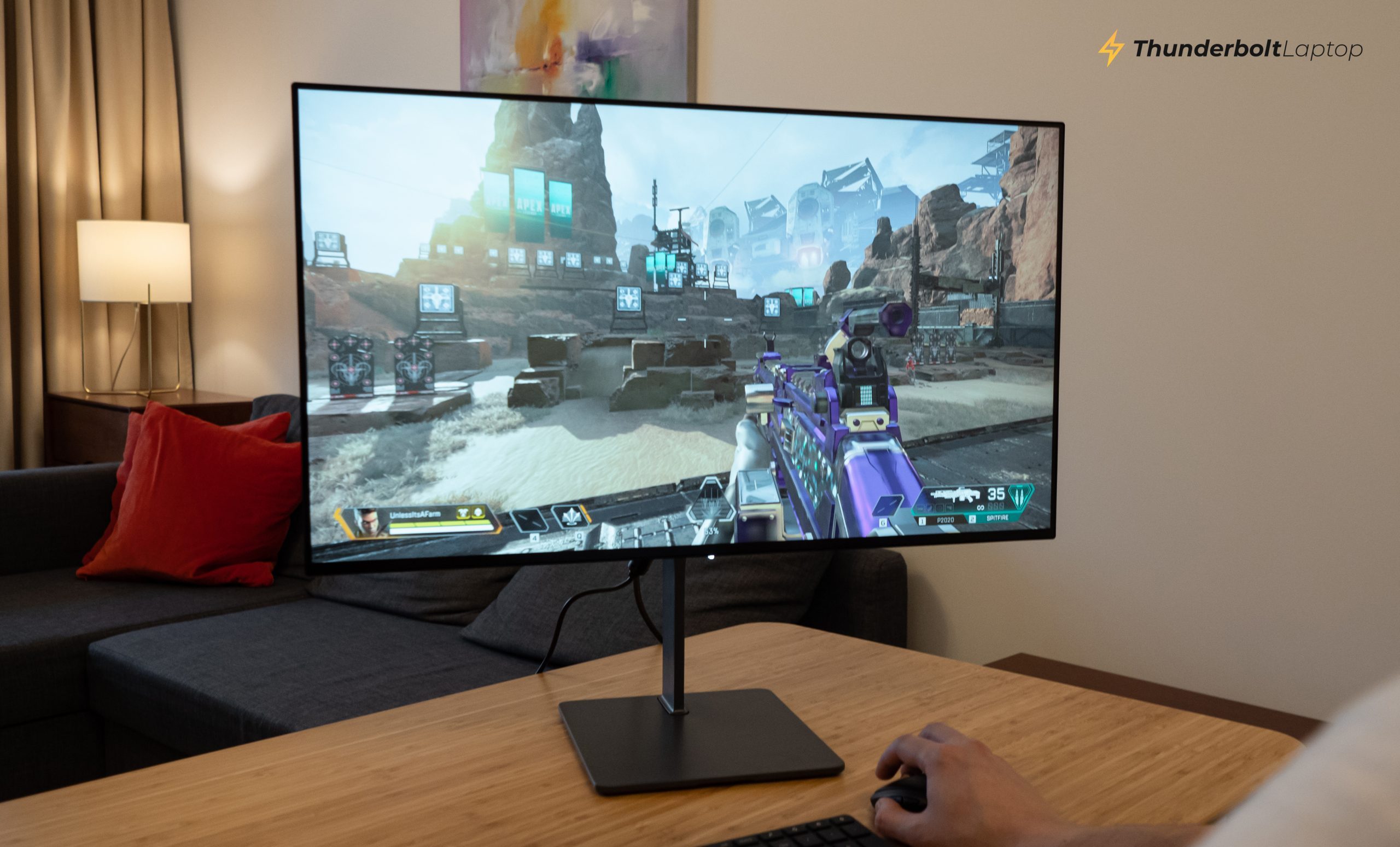




Eve Spectrum now has the HDMI 2.1 working as of last week. It will be the first 4k 120hz hdmi 2.1 monitors to release with a shipping date of June 2021
I like the ROG Strix XG43UQ display, but how to connect ROG Zephyrus GX501GI laptop that only has a mini display port for outputting up to 144Hz using G-Sync?
I see the display doesn’t have mini-display port connection & no g-sync.